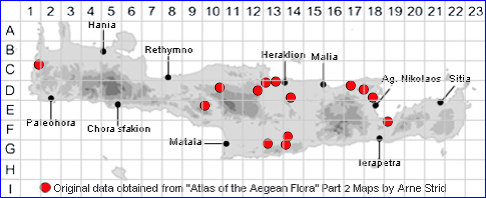
DIANTHUS TRIPUNCTATUS
Family and Genus:- See- CARYOPHYLLACEAE/Subgen. DIANTHUS
Common Names:- None
Homotypic Synonyms:- None
Meaning:- Dianthus (Gr) Zeus'-flower. a name used by the Greek philosopher
Theophrastus.
Tripunctatus (L) With three spots.
General description:- Short to medium hairless annual.
Stems:-
1) Erect, 15-50 cm, divaricately branched; branches rather rigid, nodes swollen.
Leaves:-
1) Linear to lanceolate
a) basal, usually ± withered at anthesis, 3-8 mm wide, oblong-spatulate, obtuse.
b) cauline, linear, acuminate, shorter than or equalling the intemodes; sheaths
short.
Flowers:-
1) Epicalyx-scales, c. ¾ as long as the calyx, ovate with a long, usually green,
subulate, apex.
2) Calyx, c.15 mm, conical, broadly ribbed, ribs verruculose, glabrous.
3) Petal limb, c. 8 x 5 mm, sharply dentate in front, glabrous or sparsely pilose,
pinkish-purple above, greenish-yellow beneath. with 3 red spots at the base.
Fruit:-
1) Capsule, dehiscing, apically with 4 teeth, carpophore often present.
2) Seeds numerous, concave on 1 side.
Key features:-
1) Calyx, glabrous; verruculose.
2) Annual, with slender stock and root.
3) Non-flowering stems, absent.
Habitat:- Dry open shrubby vegetation, dry grassland, open coniferous woodland,
fallow fields and vineyards, mainly on noncalcareous substrates, 0-800 m.
Distribution:- A few records from NW Peloponnisos but not elsewhere in Greece. -
Also in Italy (rare), W & S Anatolia, Cyprus, Syria and Palestine.
Limited distribution on Crete.
Flowering time:- May-July.
Photos by:- Steve Lenton
SPECIES DESCRIPTION
